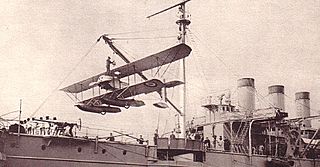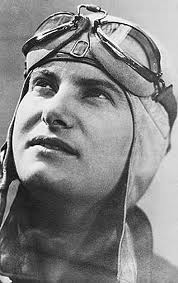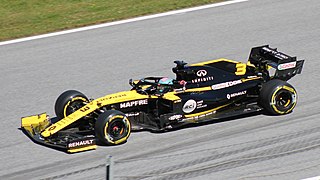
Groupe Renault is a French multinational automobile manufacturer established in 1899. The company produces a range of cars and vans, and in the past has manufactured trucks, tractors, tanks, buses/coaches, aircraft and aircraft engines, and autorail vehicles.

The French automotive manufacturer Renault has been associated with Formula One as both team owner and engine manufacturer for various periods since 1977. In 1977, the company entered Formula One as a constructor, introducing the turbo engine to Formula One with its EF1 engine. In 1983, Renault began supplying engines to other teams. Although the Renault team had won races, it withdrew at the end of 1985. Renault engines continued to be raced until 1986.

The Renault Clio is a supermini car (B-segment), produced by French automobile manufacturer Renault. It was launched in 1990, and entered its fifth generation in 2019. The Clio has had substantial critical and commercial success, being consistently one of Europe's top-selling cars since its launch, and it is largely credited with restoring Renault's reputation and stature after a difficult second half of the 1980s. The Clio is one of only two cars, the other being the Volkswagen Golf, to have been voted European Car of the Year twice, in 1991 and 2006.

The Renault Mégane is a small family car produced by the French car manufacturer Renault since the end of 1995, and was the successor to the Renault 19. The Mégane has been offered in three and five door hatchback, saloon, coupé, convertible and estate bodystyles at various points in its lifetime, and having been through three generations is now in its fourth incarnation.

Flavio Briatore is an Italian businessman. He started his career as a restaurant manager and insurance salesman in Italy. Briatore was convicted in Italy on several fraud charges in the 1980s, receiving two prison sentences, though the convictions were later extinguished by an amnesty. Briatore set up a number of successful Benetton franchises as a fugitive in the Virgin Islands and the United States. In 1990, he was promoted by Luciano Benetton to manage the Benetton Formula One racing team, which became Renault F1 in 2002. From 2007 to 2010, he was part-owner and chairman of London's Queens Park Rangers F.C. On 16 September 2009, Briatore was forced to resign from the ING Renault F1 team due to his involvement in race fixing at the 2008 Singapore Grand Prix. After the Fédération Internationale de l'Automobile (FIA) conducted its own investigation, Briatore was banned indefinitely from any events sanctioned by the FIA, although this ban was later overturned by a French Tribunal de Grande Instance.

The Société des Avions Caudron was a French aircraft company founded in 1909 as the Association Aéroplanes Caudron Frères by brothers Gaston Caudron (1882–1915) and René Caudron (1884–1959). It was one of the earliest aircraft manufacturers in France and produced planes for the military in both World War I and World War II. From 1933 onwards, it was a subsidiary of Renault.

Robert Józef Kubica is a Polish racing driver. He became the first and, as of 2020, only Polish driver to compete in Formula One. Between 2006 and 2009 he drove for the BMW Sauber F1 team, promoted from test driver to race driver during 2006. In June 2008, Kubica took his maiden Formula One victory in the Canadian Grand Prix, becoming the first Polish driver to win a Formula One race. That season he led the championship at one stage, before finishing fourth overall, his best career position. Kubica drove for Renault in 2010 and was set to remain with the team in 2011. Several years later Kubica confirmed he had signed a pre-contract for the 2012 season with Ferrari, a move that was eventually cancelled by his devastating rally crash in the winter of 2011.

The Renault Vivastella was an executive car introduced by Renault in October 1928 and produced for the model years 1929 - 1939.

The C-segment is the third smallest of the European segments for passenger cars and is described as "medium cars". It is equivalent to the Euro NCAP "small family car" size class, and the compact car category in the United States.

The Caudron C.450 and C.460 were French racing aircraft built to participate in the Coupe Deutsch de la Meurthe race of 1934.

Hélène Boucher was a well-known French pilot in the early 1930s, when she set several women's world speed records, including one which was also a world record for either sex. She was killed in an accident in 1934.

The Delahaye 135 was an automobile manufactured by Delahaye. Designed by young engineer Jean François, it was produced from 1935 until 1954 in many different body styles. A sporting tourer, it was also popular for racing.
France was a pioneer in the automotive industry and is the 11th-largest automobile manufacturer in the world by 2015 unit production and the third-largest in Europe. It had consistently been the 4th-largest from the end of World War II up to 2000.
Bernard Dudot is a French engineer who was instrumental in the development of the turbo V6 and normally aspirated V10 engines of Formula One while working for Alpine and Renault. As of 2005, he is Head of Engineering of the GP2 Series. He has a similar role in GP3 Series since the creation of that category. He is also a consultant for Le Mans organisation.

The Vivaquatre is a car produced by Renault between 1932 and 1939. Its large 4-cylinder engine placed it initially in the 10CV car tax class, though a larger engine later made it a contender in the 11CV class.

The Renault Vivasport was a 6-cylinder engined executive automobile introduced by Renault in September 1933 and produced till April 1935. A larger engined version was produced between December 1934 and February 1938. As with many Renaults during the 1930s, type changes as well as small often cosmetic facelifts and upgrades appeared frequently.

The Renault Nervasport was a straight-eight engined sporting luxury automobile introduced by Renault in March 1932 and produced until 1935. It was based on the larger and heavier Nervastella. A more streamlined version called the Nerva Grand Sport appeared in 1935 and replaced the Nervasport, remaining in production until the summer of 1937. As with many Renaults during the 1930s, type changes as well as small often cosmetic facelifts and upgrades appeared frequently.

The Caudron C.430 Rafale was a fast, two seat French touring monoplane. Soon after its first flight in 1933 it set an international class speed record.

The Renault R.S.19 is a Formula One racing car designed and constructed by the Renault F1 Team to compete during the 2019 FIA Formula One World Championship. The chassis was designed by Nick Chester, Chris Cooney, Martin Tolliday, Simon Virrill and Pete Machin with Marcin Budkowski overseeing the design and production of the car as executive technical director and Rémi Taffin leading the powertrain design. The car was driven by Nico Hülkenberg and Daniel Ricciardo. The car made its competitive debut at the 2019 Australian Grand Prix.

















